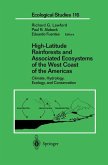The rivers of Florida vary widely in their geographical characteristics, ranging from subtropical to moderate climate ecosystems. With the drastic population increase in this state, many river habitats are threatened by destruction, be it through housing development, excessive drainage for drinking water, or contamination. The diverse river systems in question, many of them unique yet highly applicable as case studies for the other parts of the country, are examined from several angles, including geography, vegetation, fisheries, response to physical modification, and ecological stability. Written with the ecologist as well as the environmental practitioner and policymaker in mind, it attempts to arrive at scientifically-based suggestions for river management and preservation. Its publication is especially timely in light of the widespread public concern over the issue and accompanying media coverage.
This book addresses basic questions concerning the ecological relationships and current conditions of the major river systems in Florida . . There have been relatively few comprehensive studies made of the rivers of Florida. There is, to be sure, voluminous information that addresses various aspects of riverine ecology. However, little such information has been collected in a way that allows even a preliminary understanding of the driving forces that determine how the diverse freshwater and associated brackish systems function. This lack of useful data is the product of a fundamental ignorance concerning the scale of endeavor, both spatially and temporally, that is needed if we are to understand and, parenthetically, manage the major drainage systems of this area of the country (Livingston, 1987). Research used to address management problems should entail a continuous series of interrelated studies, descriptive and experimental, that answer the immediate (and often less important) questions that are asked on a day-to-day basis. The research should also be designed to answer questions that have not yet been asked. In other words, ecosystem research should be organized on an appropriate scale so that system-wide processes are understood and pr
Hinweis: Dieser Artikel kann nur an eine deutsche Lieferadresse ausgeliefert werden.
This book addresses basic questions concerning the ecological relationships and current conditions of the major river systems in Florida . . There have been relatively few comprehensive studies made of the rivers of Florida. There is, to be sure, voluminous information that addresses various aspects of riverine ecology. However, little such information has been collected in a way that allows even a preliminary understanding of the driving forces that determine how the diverse freshwater and associated brackish systems function. This lack of useful data is the product of a fundamental ignorance concerning the scale of endeavor, both spatially and temporally, that is needed if we are to understand and, parenthetically, manage the major drainage systems of this area of the country (Livingston, 1987). Research used to address management problems should entail a continuous series of interrelated studies, descriptive and experimental, that answer the immediate (and often less important) questions that are asked on a day-to-day basis. The research should also be designed to answer questions that have not yet been asked. In other words, ecosystem research should be organized on an appropriate scale so that system-wide processes are understood and pr
Hinweis: Dieser Artikel kann nur an eine deutsche Lieferadresse ausgeliefert werden.








